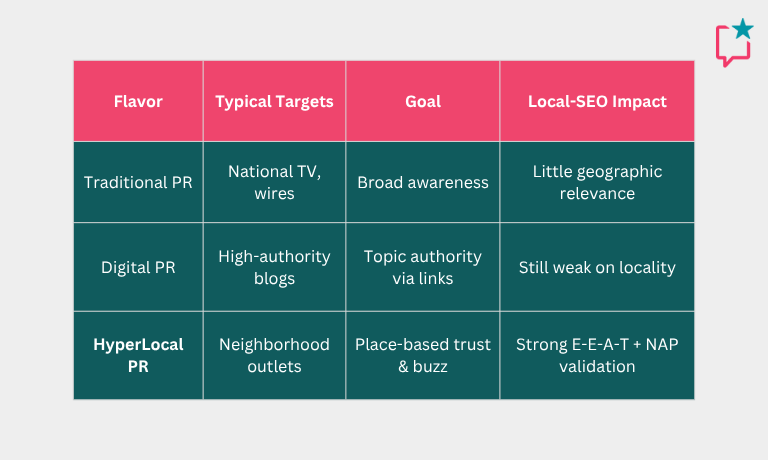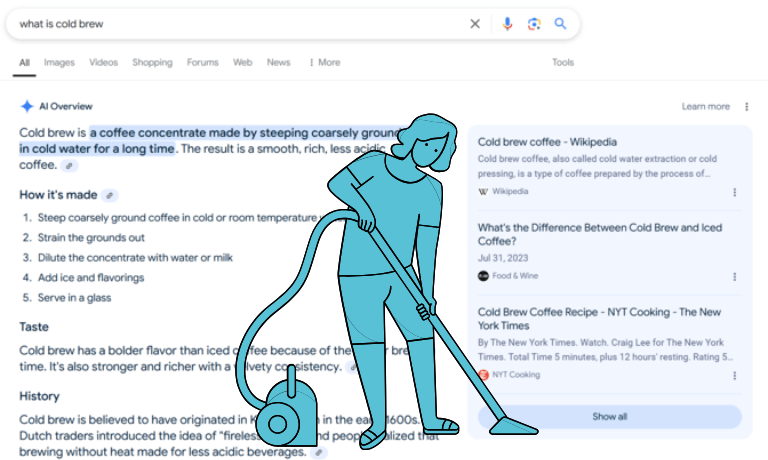
Picture it: With half-price cappuccino in hand, guests trickle out of “The Art of Coffee” art show being hosted by a neighborhood café. The brew is great, the art is evocative. By late afternoon, the coffee shop owner has submitted a write-up of the event to the town’s most influential hyperlocal blogger, and has filled their social profile with photos, reels, shorts, and stories. By night, new reviews from delighted attendees are lighting up the café’s Google Business Profile, and by the next morning, there’s coverage of the occasion on online local news, thanks to that invitation to a friendly reporter. Within a few days, this small business is outranking the nearby branch of a national coffee chain for the phrase “best cappuccino near me” in Google’s local packs and is being cited by AI for tons of new customers.
What you’ve just pictured is the way forward. Community coverage across multiple online channels + customer coverage in the form of reviews creates street-level authority that’s been brewed to the taste of both Google bots and AI scrapers. Put this into practice for your own local business with the following practical tips.
Why I think you’re going to love hyperlocal PR

Maybe you can relate – I feel stormy about AI. I’m way tired of its hype, irked about its ethics, and disdainful of its inaccuracies. If you feel the same, then I especially want to share the very shiny silver lining to the AI cloud with you. I never expected AI to take us “back to the future”, but that’s exactly what it’s doing. In an AI-aware marketing dynamic, your local business gets to focus a lot more on doing meaningful real-world stuff and, perhaps, a little less on the 20-year hunt for online clicks.
Why is that? Because AI is a hyperlocal PR vacuum cleaner trying to suck up anything it can to generate answer tokens that match user prompts. I can’t call AI intelligent, but I can recognize that it’s hungry for information about your business, and I’m feeling surprisingly chuffed that this means you and your staff get to go back to delighting your community in the real world so that it buzzes about you online.
And just what is this hyperlocal PR? It’s storytelling done by you and your neighbors. It’s having something to talk about because your brand and the customers who live nearest you feel invested in what’s happening in local life. There’s something so authentic and sensible about this, and I hope you’ll get a positive, empowered feeling from my explanation of how to make this work for your business.
Traditional PR vs. Digital PR vs. HyperLocal PR

Hyperlocal PR takes all the best parts of traditional and digital PR and makes them relevant to a specific geographic community. At the big business level, you’ll see major brands like Jack in the Box using Nextdoor’s hyper-granular ads to drive a million store visits in just two days. At the smaller end of the local business scale, a friend was just telling me how she watched her tiny neighborhood barbecue joint jump three spots in the local pack after a single column was published about them in an online church bulletin. Even a modest expansion of your digital footprint can bring many new customers in your door.
Why SEOs want you to get your store’s floor good and dirty for the AIO vacuum cleaner

Google’s AI overviews (like the one shown above describing the cost of coffee in Seattle) are baked right into the SERPs. Need to know:
- AI Overviews (AIOs) are currently appearing for 68% of local-type queries, according to a new study from Whitespark
- The same study concludes that 60% of the content being scraped and cited by AIOs comes from third party publishers (think Reddit, Indeed, Thumbtack, etc.) while the remaining 40% is coming directly from business websites.
Appearing in these prominent AI-generated results is all about ensuring they can find plenty of information about your business on your own site and on third party publishers.If the users of products like AI overviews and ChatGPT ask questions about your business for which these systems don’t have data, they will either cite your competitors or make up nonsense answers. SEOs are currently building new best practices around this dynamic, and for local businesses, there are multiple ways to ensure that AI can “vacuum up” everything they need in order to provide relevant answers to user queries. Let’s cover your options!
Your Local Business’ Tactical Playbook in the AI era
Use this step-by-step guide to dig into AI-aware local business marketing
Step 1: Map out your hyperlocal media grid
Create a spreadsheet or other document detailing all relevant publishers in your local community. Your list could include:
- Traditional online newspapers (be sure your doc includes the names and contact information of reporters who cover local business news, local lifestyle pieces, local events, etc.)
- Any online platform that is a hub for your community, including neighborhood sites like Nextdoor, subreddits for your town on Reddit, and community portals like this example for West Seattle that features local stories, forums, weather, etc.
- Hyperlocal blogs that regularly publish information about your community. If you’re in a prominent industry in a large city, you can typically find best-of type lists like the one shown about for the best food blogs in San Francisco. In small towns, you may have fewer options, but every one is valuable.
- Local podcasters who accept local guests and advertisers
- Local YouTube channels that accept guests and sponsors
- Local social media influencers who do stories and reviews on local businesses
- Any local website with a sponsorship page (search your city name + “our sponsor”, “sponsorships” or “sponsor us” in Google). This could include charitable institutions, events, teams, community projects, and a variety of causes.
- The newsletters, bulletins, or other publications of local schools, houses of worship, city councils, volunteer fire departments, etc.
- Local lifestyle and tourism magazines published by your city and visitor centers
- Local educational institutions that accept scholarship offers (search your city + “scholarships).
- Local TV, radio, billboards, mailers
- Local event calendars that offer opportunities for your business to participate in upcoming happenings
- Local job listing platforms that accept postings from nearby businesses
- Press release publishers that accept submissions from local businesses
If you’ve been marketing local businesses for some years, you’ll have quickly recognized that most of the entries in the doc you’re creating are what have long been celebrated as sources of “unstructured citations” – online mentions of your business information on any third party publisher. Historically, unstructured citations have been prized for the ability to grow your digital footprint and increase brand discovery. In the AI dynamic, this traditional form of digital PR is coming to the fore as one of the best ways to feed AI scrapers. It’s good news!
Pro tip: Ideally, many of the above sources will be AI-scrapable, but remember that even if they aren’t, any source of PR is still valuable if it creates real-world awareness and buzz about your local business that ends up being talked about both offline and online.
Step 2. Back up your unstructured citations with structured ones
Structured citations are listings of your business on formal local business indexes, like Google Business Profile, Yelp, TripAdvisor, Bing Places, etc. These platforms enable you to create rich listings filled with:
- Basic contact information
- Owner-uploaded and user-uploaded photos of every aspect of your business
- Descriptions
- Menus
- Services
- Products
- Attributes
- Social media links
- Many other forms of content
Create, verify, and maintain accurate listings on prominent local directories so that AI has correct information to display about your brand’s locations. Pay particular attention to your Google Business Profile and Bing Places listings, so that AI Overviews and ChatGPT have “in-house” sources of information about your company.
Step 3: Think like an AI token machine in your hyper local PR
In steps 1 and 2 of your local AI playbook, you identified lots of opportunities to earn and create publicity both offline and online in your community. How you outreach and get cited matters!
Typically, the large language models (LLMs) that operate AI are based on a system of tokenization. Tokens can be thought of as the smallest building blocks of words and partial words the AI can “understand”. If you think of AI as kind of old school video game arcade, your local business wants to feed it plenty of tokens, including:
- Your brand name
- Your location information
- Your contact data
- The things for which your brand most needs to be known to the public
You want to fill the AI machine with tokens that, for example, frequently suggest that “Mike’s” “Pizza” in “downtown” “Portland” “Oregon” is highly associated with the “best” “organic” “vegan” “pizza”, if that’s your company’s unique value proposition.
In building unstructured citations, you almost always have the opportunity to specify how you want to be cited. For example, if your restaurant gets listed as a sponsor of your community’s Fourth of July picnic, you could request to be listed as:
Mike’s Pizza: Portland’s Best Organic Vegan Pizza
Now imagine getting this same type of citation everywhere you sponsor, guest speak, guest write, get interviewed, and publish. Thanks to tokenization, AI will come to “understand” that “Mike’s pizza” frequently appears in close proximity” to the other words in your PR outreach, so that when a potential customer queries Google or ChatGPT, they are likely to be shown your business as a relevant answer.
For this step in your playbook, identify the phrases for which your business most needs to be known and focus on them in all your PR outreach.
Step 4: Publish for social appetites
Get into the habit of publishing content that directly feeds into what the public likes to share on social media, namely:
- Photos
- Videos
- Statistics
- Snackable quotes
- Emotion-based stories
Search Engine Land has a good breakdown of the sources that are being most frequently cited by ChatGPT, AI Overviews, and Perplexity, and one takeaway from their study is that brand visibility on platforms like Reddit and Quora feeds AI outputs. This type of activity should be part of your gameplan, but it’s also vital to avoid coming to the conclusion that the point of your social media activity is to be visible to AI.
A more holistic view of PR in the AI era is that your business should be doing real things that real people react to. Emotional targeting will increasingly be part of the playbook of most marketers who are seeking to understand consumer psychology. At a local level, finding the sweet spot for what your community likes to share about on social media will enable your business to:
- Build brand recognition
- Build community based on human-to-human relationships
- Build discovery
- Build loyalty
- Build the real estate you’re occupying in traditional organic results, thanks to brands like Google filling your branded results with social conversations about your company
- And also, hopefully, build token-based inclusion in AI outputs
Pro tip: Before the internet, local businesses like user car dealerships relied heavily on gimmicks like jumping out of airplanes to try to elicit an emotional response from TV audiences. While wacky content can still create a social buzz, don’t lose site of the long game in your local/social PR: you’re hoping to build long-term loyal relationships by making people’s lives better in your community. Authenticity, empathy, expertise, and generosity are good ideals to build good social campaigns around in 2025.
Step 5: Online reviews – the grassroots citations
In steps 1-4 in your playbook, you focused on ways and means of using PR to get your business cited and shared. Step 5 completes the picture by going directly to the customer for their own authoritative words in the form of reviews and testimonials.
Aspects of reviews like rating, velocity, recency, and volume have long been considered foundational local search ranking factors, and that hasn’t changed. AI-aware marketing adds a new layer to this picture because LLMs are now frequently directly citing reviews.
This can come in the form of review summaries, like this example from ChatGPT:
Or this one, like Google’s AI Mode citing major review platforms like Yelp and TripAdvisor or social platforms like Reddit:
Here’s a capture from Andy Simpson showing AI Mode directly embedding GBP review stars, counts and sentiment directly into its results:
And a similar example in an AI Overview, with Google citing TripAdvisor as well as Facebook and a local food blog:
Gatherup’s own large-scale consumer review survey discovered that:
- Less that 1% of the public never consults local business reviews before making a purchase – this is content that’s consulted by almost everyone!
- 85% of the public trusts reviews to at least some extent – given AI’s notorious habit of hallucinating irrelevant answers, seeing reviews in an AI output could help enquirers feel more trusting of what they are being shown in environments like ChatGPT or AI Overviews.
- 60% of consumers trust what customers say about brands more than what brands say about themselves – when your business invests in review acquisition, it’s investing in what is almost certainly the most influential form of PR.
In the hyperlocal PR dynamic, your business can establish a marketing flywheel that looks like this:
Do something local that matters to your community → get a small surge of genuine reviews in response → enjoy a possible local search ranking boost and new publicity in the form of aspects of your new reviews being cited in local pack justifications → fresh reviews to remarket socially → social and review content being picked up by AI → more brand discovery → more foot traffic → more sales → more interactions with new customers → fresh PR angles → repeat.
To kickoff this virtual cycle for your business, you just need to:
- Promote something noteworthy about your business
- Back it up with an excellent real-world customer experience
- Actively ask for reviews
Close the review loop by:
- Responding to all reviews you receive, with thanks for positive sentiment and offers to make things right when complaints occur
- Remarketing your reviews both online and via in-store signage and multi-channel advertising
- Going beyond third-party reviews to first–party review and testimonial acquisition that you publish on your own website.
Common blunders (and friendly fixes)
While I’m hoping you’re really seeing the potential in AI’s silver lining right now, take just a minute to scan this list of mistakes you want to avoid:
- Don’t assume your customers love AI – Spend a few minutes on any social platform and you’ll quickly note the hostility many people feel towards this technology. Don’t make the mistake of assuming real people staffing your phones, textlines, livechat, and company can be replaced by AI without angering your customer base. Keep customer service and consumer experiences at the base of your operations at all times!
- Don’t promote where you’re not welcome – Particularly in social settings, don’t violate community guidelines by promoting your business where this type of activity isn’t allowed. Instead, participate without selling in local social communities; be a good neighbor whom people come to like.
- Don’t blow your PR wins with review gating – Don’t suppress negative sentiment when a successful PR campaign brings in new reviews. Review gating violates multiple policies, and in some countries, laws! Invite everyone to have their say and be prepared to respond well to critiques with offers to make things right.
- Don’t neglect basic NAP consistency – AI is already error-prone enough; the last thing you want is for it be picking up old versions of your brand name, former addresses, past phone numbers, or outdated hours. Keep your structured and unstructured citations, plus your own website and social profile continuously accurate. When a major NAP+hours change occurs, you’ll need to audit and update as many instances as possible across the web so that bots, scrapers, and real people are encountering correct information about your locations. Don’t forget to update your schema!
- Don’t be afraid to be truly hyperlocal – If you operate in a large city with multiple neighborhoods, experiment with gearing your press releases, social content, and other PR towards those smaller communities. The “near me” aspect of local is truly powerful, and AI users now have a way to keep prompting environments like ChatGPT to find what’s truly nearest them.
Two-step perfection!
Pros make dancing the two-step look easy, but when you talk to them, they’re quick to say their suavity is the result of lots of practice. Your local business is going to have plenty of wins and fails. That’s how you’ll learn to dance this new two-step of hyperlocal PR + online reviews. Wrapping up, you’ve learn that:
- HyperLocal PR is something you can actively engage in to grow your digital footprint, engage with your community, and increase your prominence in both traditional local SEO results and AI environments
- Online reviews provide nonstop, experience-driven citations that are highly trusted by the public, impact local rank, and are also making their way into AI.
Together they form a resilient feedback loop that AIO, ChatGPT, and classic map-pack algorithms all respect. Get both steps right and your brand will be doing what it needs to embrace the AI silver lining that lets you focus on doing real things that matter to real customers.
Want to know what the pros are saying about AI and local search right now? Watch Mél Attia chatting with Greg Sterling and Mike Blumenthal about the review component of AI in this video short:
Need a dance instructor who really gets what’s going on with AI in the local business world? Contact GatherUp.
